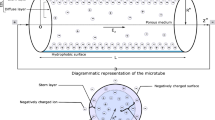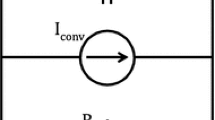Abstract
In this paper, we investigate theoretically the 3D laminar flow of an electrolyte in an annular duct driven by a Lorentz force. The duct is formed by two concentric electrically conducting cylinders limited by insulating bottom and top walls. A uniform magnetic field acts along the axial direction, while a potential difference is applied between the cylinders so that a radial electric current traverses the fluid. The interaction of the current and the magnetic field produces a Lorentz force that drives an azimuthal flow. The steady flow is solved using a Galerkin method with Bessel–Fourier series in the radial direction and trigonometric series along the vertical direction, allowing different combinations of slip conditions at the walls. The orthogonality of both series with the general boundary conditions of the third kind is used to find an analytic approximation. Velocity patterns and flow rates are explored by varying the aspect ratio of the duct and the gap between the cylinders, as well as the slippage at the walls. Results can provide useful information for optimization and design of annular microfluidic devices.
















Similar content being viewed by others
References
Abramowitz M, Stegun IA (1964) Handbook of mathematical functions: with formulas, graphs, and mathematical tables. Courier Corporation, North Chelmsford
Arumugam PU, Fakunle ES, Anderson EC, Evans SR, King KG, Aguilar ZP, Carter CS, Fritsch I (2006) Redox magnetohydrodynamics in a microfluidic channel: characterization and pumping. J Electrochem Soc 153:E185–E194
Bao JB, Harrison DJ (2003) Fabrication of microchips for running liquid chromatography by magnetohydrodynamic flow. In: Proceedings of the 7th international conference on miniaturized chemical and biochemical analysts systems, Squaw Valley
Bau HH, Zhu J, Qian S, Xiang Y (2003) A magneto-hydrodynamically controlled fluidic network. Sens Actuators B: Chem 88(2):205–216
Behr M (2004) On the application of slip boundary condition on curved boundaries. Int J Numer Methods Fluids 45(1):43–51
Digilov RM (2007) Making a fluid rotate: circular flow of a weakly conducting fluid induced by a Lorentz body force. Am J Phys 75(4):361–367
Einzel D, Panzer P, Liu M (1990) Boundary condition for fluid flow: curved or rough surfaces. Phys Rev Lett 64(19):2269
Enright R, Ghosh A, Gallagher A, Lei S, Persoons T (2016) Apparent slip enhanced magnetohydrodynamic pump. In: 2016 15th IEEE intersociety conference on thermal and thermomechanical phenomena in electronic systems (ITherm). IEEE, pp 1030–1034
Finlayson BA (1968) The Galerkin method applied to convective instability problems. J Fluid Mech 17(1):201–208
Finlayson BA (1972) The method of weighted residuals and variational principles. Mathematics in science and engineering. Academic, New York
Gleeson JP (2005) Transient micromixing: examples of laminar and chaotic stirring. Phys Fluids 17(10):100,614
Homsy A, Koster S, Eijkel JC, van den Berg A, Lucklum F, Verpoorte E, de Rooij NF (2005) A high current density DC magnetohydrodynamic (MHD) micropump. Lab Chip 5(4):466–471
Huang L, Wang W, Murphy M, Lian K, Ling ZG (2000) Liga fabrication and test of a DC type magnetohydrodynamic (MHD) micropump. Microsyst Technol 6(6):235–240
Kabbani H, Wang A, Luo X, Qian S (2007) Modeling redox-based magnetohydrodynamics in three-dimensional microfluidic channels. Phys Fluids (1994-Present) 19(8):083,604
Kang HJ, Choi B (2011) Development of the MHD micropump with mixing function. Sens Actuators A 165(2):439–445
Krymov V (1989) Stability and supercritical regimes of quasi-two-dimensional shear flow in the presence of external friction (experiment). Fluid Dyn 24(2):170–176
Laser DJ, Santiago JG (2004) A review of micropumps. J Micromech Microeng 14(6):R35
Lauga E, Brenner M, Stone H (2007) Microfluidics: the no-slip boundary condition. In: Tropea C et al (eds) Springer handbook of experimental fluid mechanics. Springer, Berlin, Heidelberg, pp 1219–1240. doi:10.1007/978-3-540-30299-5_19
Lemoff AV, Lee AP (2000) An AC magnetohydrodynamic micropump. Sens Actuators B: Chem 63(3):178–185
Li D (2008) Encyclopedia of microfluidics and nanofluidics. Springer Science & Business Media, Berlin
Nguyen B, Kassegne SK (2008) High-current density dc magenetohydrodynamics micropump with bubble isolation and release system. Microfluid Nanofluid 5(3):383–393
Ortiz-Pérez AS, Dávalos-Orozco LA (2011) Convection in a horizontal fluid layer under an inclined temperature gradient. Phys Fluids 23:084107-1–084107-11
Patel V, Kassegne SK (2007) Electroosmosis and thermal effects in magnetohydrodynamic (MHD) micropumps using 3D MHD equations. Sens Actuators B: Chem 122(1):42–52
Pérez-Barrera J, Pérez-Espinoza J, Ortiz A, Ramos E, Cuevas S (2015) Instability of electrolyte flow driven by an azimuthal Lorentz force. Magnetohydrodynamics 51(2):203–213
Pérez-Barrera J, Ortiz A, Cuevas S (2016) Analysis of an annular MHD stirrer for microfluidic applications. In: Klapp J et al (eds) Recent advances in fluid dynamics with environmental applications. Springer, Berlin, pp 275–288
Qian S, Bau HH (2009) Magneto-hydrodynamics based microfluidics. Mech Res Commun 36(1):10–21
Qin M, Bau HH (2011) When MHD-based microfluidics is equivalent to pressure-driven flow. Microfluid Nanofluid 10:287–300
Qin M, Bau HH (2012) Magnetohydrodynamic flow of a binary electrolyte in a concentric annulus. Phys Fluids 24:037101-1–037101-20
Rivero M, Cuevas S (2012) Analysis of the slip condition in magnetohydrodynamic (MHD) micropumps. Sens Actuators B: Chem 166167:884–892
Smolentsev S (2009) MHD duct flows under hydrodynamic slip condition. Theor Comput Fluid Dyn 23(6):557–570
Stelzer Z, Cbron D, Miralles S, Vantieghem S, Noir J, Scarfe P, Jackson A (2015a) Experimental and numerical study of electrically driven magnetohydrodynamic flow in a modified cylindrical annulus. I. Base flow. Phys Fluids 27(7):077,101
Stelzer Z, Miralles S, Cébron D, Noir J, Vantieghem S, Jackson A (2015b) Experimental and numerical study of electrically driven magnetohydrodynamic flow in a modified cylindrical annulus. II. Instabilities. Phys Fluids (1994 Present) 27(8):084108
Stroock AD, Weck M, Chiu DT, Huck WT, Kenis PJ, Ismagilov RF, Whitesides GM (2000) Patterning electro-osmotic flow with patterned surface charge. Phys Rev Lett 84(15):3314
Tallarek U, Rapp E, Seidel-Morgenstern A, Van As H (2002) Electroosmotic flow phenomena in packed capillaries: from the interstitial velocities to intraparticle and boundary layer mass transfer. J Phys Chem B 106(49):12709–12721
West J, Karamata B, Lillis B, Gleeson JP, Alderman J, Collins J, Mathewson A, William L, Berney H (2002) Application of magnetohydrodynamic actuation to continuous flow chemistry. Lab Chip 2:224–230
West J, Gleeson JP, Alderman J, Collins JK, Berney H (2003) Structuring laminar flows using annular magnetohydrodynamic actuation. Sens Actuators B: Chem 96(12):190–199
Woias P (2005) Micropumpspast, progress and future prospects. Sens Actuators B: Chem 105(1):28–38
Zhao Y, Zikanov DK (2011) Instability of magnetohydrodynamic flow in a annular channel at high Hartmann number. Phys Fluids 23:0184103-1–0184103-8
Zhong J, Yi M, Bau HH (2002) Magneto hydrodynamic (MHD) pump fabricated with ceramic tapes. Sens Actuators A 96(1):59–66
Acknowledgements
A.S. Ortiz-Pérez thanks the K. of K., L. of L. and G. of G. Support from program PRODEP, Project UABC-PTC-513 and CONACYT, Mexico, Project 240785 is thankfully acknowledged. Technical support of Vicente Ortiz Jr., Salvador Melchor León, José Luis Guerrero Cervantes, Patricia Parra, Efraín Gamez, Raúl Vázquez Rios and Danyyel Farías is also acknowledged.
Author information
Authors and Affiliations
Corresponding author
Appendix
Appendix
1.1 Boundary conditions of third kind
Required boundary conditions can be applied to Bessel functions of order \(\nu\); therefore,
In compact form
1.2 Orthogonality of Bessel functions with third kind boundary conditions
After multiplying (74) by \(r u_{\nu ; n}\) and (75) by \(r v_{\nu ; m}\), then subtracting the second to the first resulting equation and integrating, we get:
The equation can be expanded and expressed as
If the \(v_{\nu ; n}\) functions either satisfy the no-slip boundary conditions \(v_{\nu ; m} (1)=v_{\nu ; m} (\eta )= v_{\nu ; n} (1 )= v_{\nu ; n} (\eta )=0\) or the boundary conditions (72) and (73), the orthogonality condition is satisfied and the right-hand side of Eq. (78) is zero. That is:
Another important result occurs when the eigenfunctions have the same eigenvalue, then multiplying the expanded form of Eq. (74) by \(2r^2\frac{{\hbox {d}} v_{\nu ; m}}{{\hbox {d}}r}\):
Using the following identities in the last expression:
Changing both sides and integrating over the region of interest \([\eta ,1]\), then:
Using again the no-slip boundary conditions \(v_{\nu ; m} (1)=v_{\nu ; m} (\eta )=0\), then
For the slip boundary conditions (72) and (73), we have:
or
where
Rights and permissions
About this article
Cite this article
Ortiz-Pérez, A.S., García-Ángel, V., Acuña-Ramírez, A. et al. Magnetohydrodynamic flow with slippage in an annular duct for microfluidic applications. Microfluid Nanofluid 21, 138 (2017). https://doi.org/10.1007/s10404-017-1972-x
Received:
Accepted:
Published:
DOI: https://doi.org/10.1007/s10404-017-1972-x




